In addition to the Holy Crown and the coronation jewels, the right hand of the founding king of Hungary, King St. Stephen, is the most precious national relic in Hungary. According to medieval sources, when the tomb of St. Stephen was opened, the relic was secretly taken by a canon from Fehérvár, who then took it to his estate in Bihar County. The matter was settled by King St. Ladislaus, who regained the Holy Right on 30 May 1084, and commissioned his own son, Prince álmos, to build a stone monastery to guard the relic instead of the wooden building where the national treasure was illegally placed in Bihar by its owner.
From Fehérvár to Ragusa
The monastery, located about 40 kilometres northeast of Oradea, and the adjacent town were named Szentjobb ('Holy Right'). The hand relic spent most of the middle ages here until the 15th century. In the 16th century, due to the decline of the monastery, it was taken to Székesfehérvár. However, the Ottoman invasion was near. The exact events are unclear, but the Holy Right ended up in the Dalmatian town of Ragusa (now called Dubrovnik in Croatian), where it was guarded by the Dominicans together with the skull of St. Stephen.
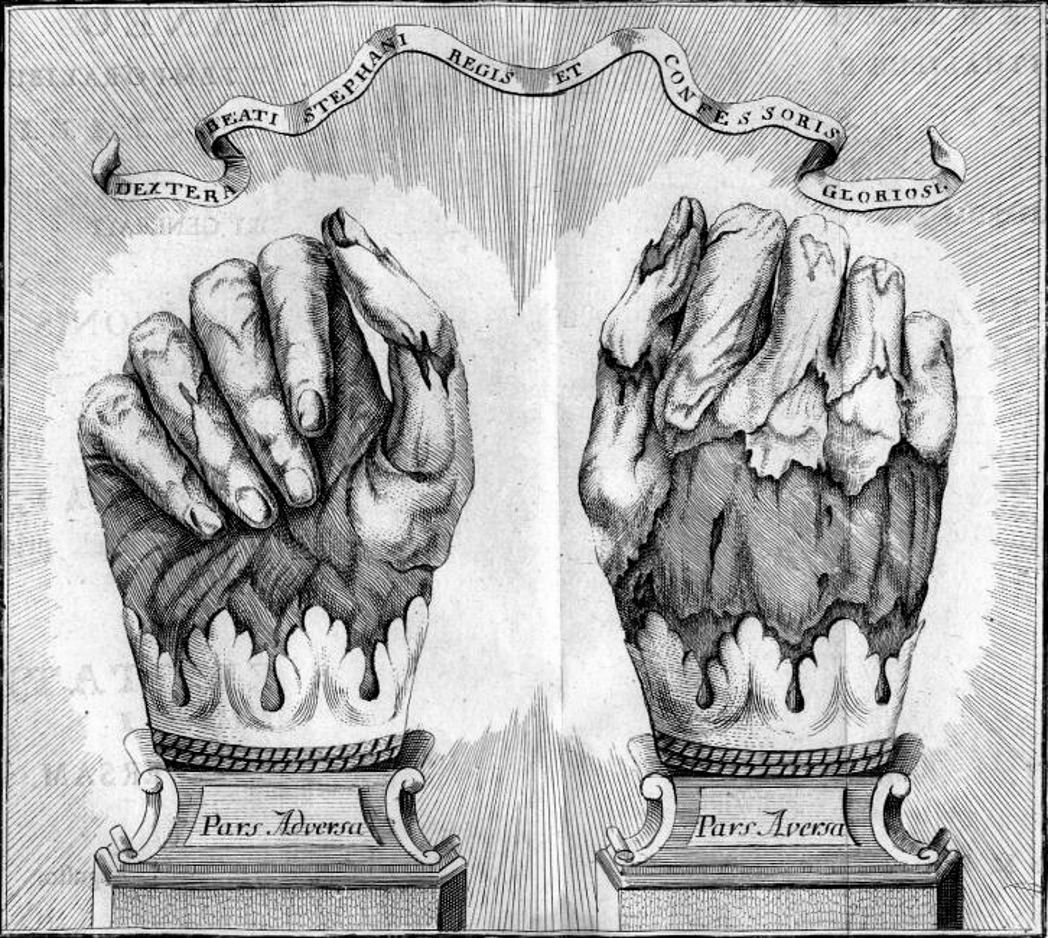
The first depiction of the Holy Right is from the work of George Pray published in Vienna in 1771
Ragusa, which traditionally had good relations with the Hungarian kings, was famous for its prestigious collection of relics and reverence of relics. Ragusan merchants are said to have purchased the relics from the Ottomans after the invaders raided the tombs of the Hungarian Kings.
The Holy Right returns home – Maria Theresa's gesture to Hungarians
It took centuries for the Holy Right to return. Maria Theresa regained it for the Hungarian nation in 1771, towards the end of her reign, as a noble gesture towards the nation. In the autumn of 1771, the Holy Right arrived in Buda in a solemn setting, travelling through Győr and Pannonhalma, where it was greeted with great joy and tolling bells. First, the relic was placed in the Sigismund Chapel in Buda Castle, and in 1778 it was moved to St. Stephen's Chapel. During the War of Independence in 1848–49, the Sigismund Chapel of Buda Castle burnt down. The Chapel of the Holy Right was rebuilt during the restoration started by Miklós Ybl and then continued and completed by Alajos Hauszmann. It became a jewel box worthy of a baroque chapel in the 19th century. The beautiful glass mosaics were made by Miksa Róth based on plans by Károly Lotz. The fate of this chapel, in which the Holy Right was preserved until 1944, was interesting. It survived the Second World War intact and then was taken from the ruined palace of Buda Castle and taken to Balatonalmádi, where it was re-assembled. As a result, this national treasure survived due to the conservation efforts of Dr Sandor Pintér, the local parish priest, and can be visited there to the present day. A fragment of the Holy Right was placed in the chapel as part of the Millenium celebrations in 2001. The chapel also houses the relics of Saint Emric and Blessed Gizella.
The Holy Right Chapel, which once opened from the Chapel of St. Sigismund in the Royal Palace of Buda, was where the Right Right was kept until 1944. The chapel was taken to Balatonalmádi in 1956 from the ruined palace (Source: Élet és Tudomány, 26 February 1982).
The tradition of St. Stephen's Day processions
St. Stephen's Day celebrations on 20 August were first decreed by Maria Theresa and became a public holiday during the reign of Francis I (Francis II as HRE). At the time, the first Holy Right procession was held in Buda, the exact rules of which were determined by Archduke Joseph the following year, in 1819. He also obliged the leaders of the society to attend the celebration. Members of the government also took part in the 1848 St. Stephen's Day procession. After the defeat of the War of Independence, the procession was banned until 1860.
After it became possible to hold the holiday again, the Holy Right processions in Buda Castle were accompanied by national interest. It was then that the large-scale St. Stephen's Day holiday we know today began to take shape. The ornate reliquary of the Holy Right, the ornate, Gothic-style chapel-like work in which it is still preserved today, was built in 1862 according to the plans of the primate's chief architect József Lippert.
The ornate reliquary of the Holy Right was made in 1862 according to the plans of the primate's chief architect József Lippert (Source: A Vasárnapi Ujság füzetekben, volume 22)
Great moments from the first half of the 20th century
Even during the storms of the 20th century, Hungarians expected protection from the right of St. Stephen. After the outbreak of the First World War, in May 1915, an extraordinary "begging" procession was held in Budapest with the participation of 120,000 people. This is likely when the Holy Righ first travelled to Pest, aboard the state carriage used for coronations. It was taken from Buda to the Inner City Parish Church and then Saint Stephen's Basilica as part of the procession, where Ottokar Prohászka, Bishop of Székesfehérvár, gave a speech.
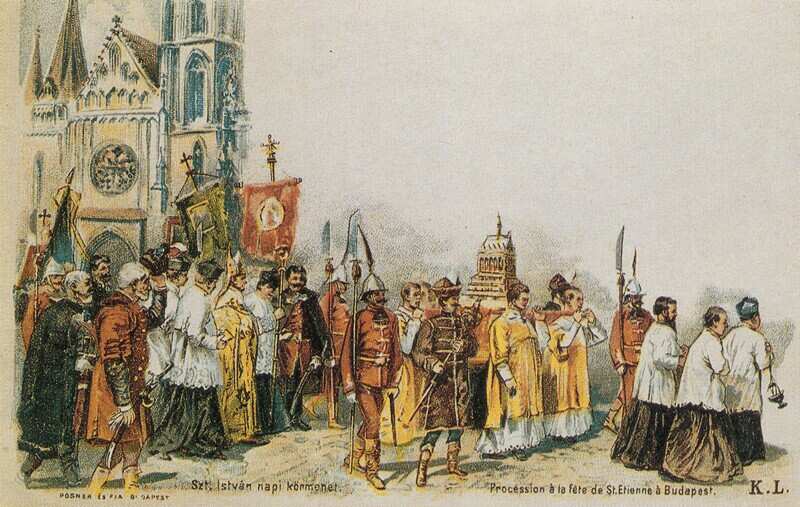
St. Stephen's Day procession in the year of the millennium (Image source: Tivadar Petercsák: A képes levelezőlap története)
The festive procession on 20 August 1930 was a similarly unique occasion. As part of the Saint Emeric year, organised to commemorate Saint Emeric, the son of Saint Stephen the Saint Ladislaus herm, stored in Győr, and the relics of St. Emeric and other relics of the Árpád Dynasty were carried in the procession alongside the Holy Right, which departed from St. Stephen's Basilica and went down Andrássy Avenue to Heroes' Square.
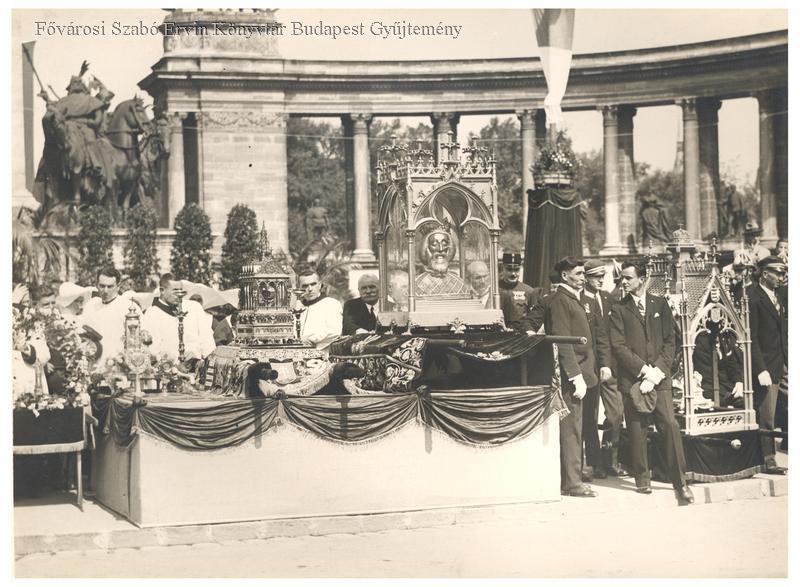
The procession held in 1930 as part of the St. Emeric Memorial Year. The picture taken in Heroes' Square shows, among other things, the St. Ladislaus herm (Photo: FSZEK Budapest Collection)
The largest-scale procession was undoubtedly held in 1938, on the 900th anniversary of St. Stephen's death: in the year of the World Eucharistic Congress, the procession of the Holy Right took place with eight hundred thousand people. The national tour of the Holy Right also happened in the same year about the Golden Train, which has finally been restored to its former glory by today.
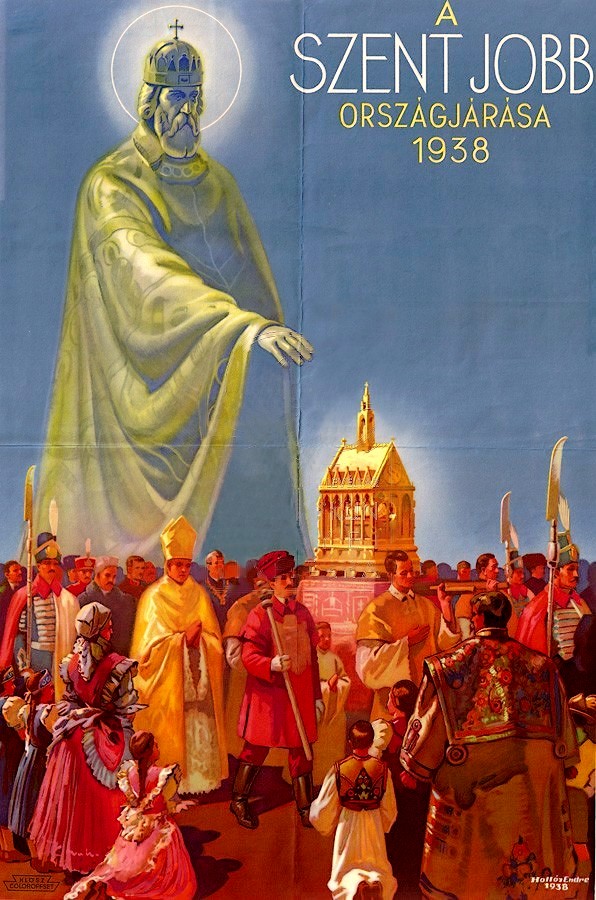
Poster made for the national tour of the Holy Right (Image source: Hungarian National Archives, Bács-Kiskun County Archives XV.)
However, this large-scale series of ceremonies marked the end of an era. Although the feast of St. Stephen was celebrated in the coming war years, in 1944, the procession was cancelled due to the risk of air raids. The relic of the Holy Right was transported by car to the main church in Buda Castle, within the walls of which t Prince Primate Justinián Serédi celebrated mass.
Restart and persecution
As the front approached Hungary, the Holy Right was moved from the country to Salzburg. After the war, it was brought back to Budapest by an American military delegation and handed over to Béla Witz, the guardian of the Holy Right, on 19 August 1945.
As a result, exactly 75 years ago, the Holy Right procession was held again, but in Pest rather than the severely damaged Buda Castle. The procession marched from the Franciscan church in Pest to St. Stephen's Basilica.
The beginnings after the war were relatively encouraging, but soon the possibility of commemorating St. Stephen outside churches was soon lost. The following years were marked by the struggle against the “clerical reaction” marked by the name of the confessional and patriotic prince-primate József Mindszenty.
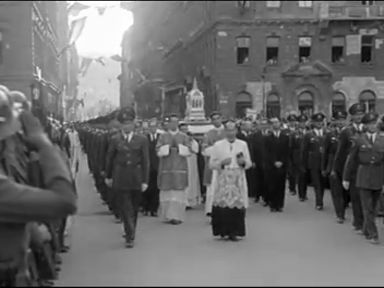
In 1947, under the leadership of Prince Primate József Mindszenty, the procession took place with the participation of military tributes and so-called public dignitaries (detail of a contemporary newsreel, MAFIRT Krónika 34.)
After nearly half a million people took part in the Holy Right procession led by Mindszenty in 1947, the following year, it was banned. Mindszenty was arrested on 26 December 26 later the same year, and a show trial began against him. József Mindszenty never took part in St. Stephen's Day celebrations on Hungarian soil again.
By forcing Mindszenty out, it seemed that the communists were no longer so afraid of the procession, at least for a time. It was allowed to go ahead the following year in Buda Castle. It can be said that everything turned out the way the government wanted. Without the chief pastor, the religious ceremony on the ruined streets of the castle did not attract much attention. Nevertheless, the day is of historical significance, as it was the last Holy Right procession in Buda Castle.
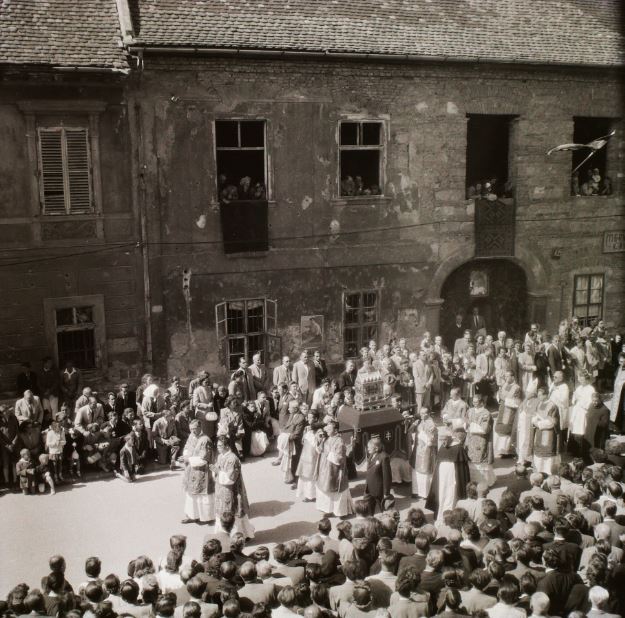
St. Stephen's Day procession in 1949 in the ruined Buda Castle (Photo: Fortepan / Image No.: 96204)
From 1950, of course, the procession could not take place in Buda. For many decades the festive Mass was presented in the presence of the Holy Right within the walls of the deteriorating St. Stephen's Basilica.
In 1991, Pope John Paul II also attended the celebration
Relief came slowly. On 20 August 1985, about fifteen thousand people attended the festive Mass in the square in front of the basilica, at which time the Holy Right was visible again in the open air. On 20 August 1987, Archbishop László Paskai consecrated the St. Right Chapel of the basilica, then in 1988, the relic went on tour again and visited the episcopal capitals of the country. These were the main stages in the process of alleviation, which resulted in the Holy Right Procession being held every year since 1989 on 20 August. In 1991, another major event took place: during his visit to Hungary, Pope John Paul II also took part in the procession, which again took place in an extraordinary way: the relic of St. Stephen was transported from the basilica to Heroes' Square by the so-called papal mobile.
Cover photo: Relics of the saints of the Árpád Dynasty during the procession held in 1930, on Heroes' Square (Photo: FSZEK Budapest Collection)

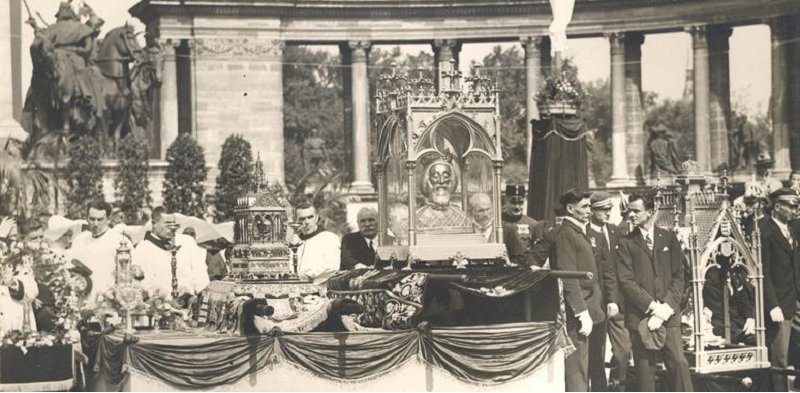

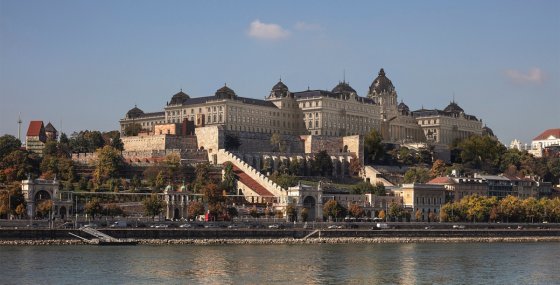



































Hozzászólások
Log in or register to comment!
Login Registration